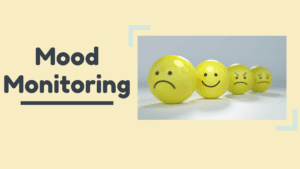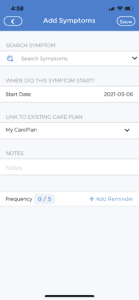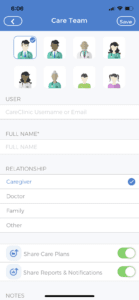
How many times have you excused your behaviour with your friends and family for being in a “bad mood”? Our moods undeniably affect our daily interactions, both positively and negatively. But, how can we practice patience with ourselves when faced with a bad mood? And how can we become aware of certain triggers and patterns that affect our moods? Bullet journal mood trackers are an incredibly effective mental health tool to not only acknowledge our feelings but in becoming self-aware of our patterns and tendencies.
What is a bullet journal mood tracker?
A bullet journal mood tracker is a personal record of one’s mood, recorded at regular time intervals. Most people choose to record their moods as a factor of their daily routine through their bullet journal mood trackers. Bullet journal mood trackers can be physical, such as in a physical journal, or digital. CareClinic is a healthcare app that allows users to digitally track their mood with ease.
Why should you use a bullet journal mood tracker? 6 benefits to tracking your mood:
1. Bullet journal mood trackers act as a space to acknowledge your feelings
Emotional variability is natural and normal for the human brain. However, we often repress these feelings when caught up in our busy lives and schedules. Moreover, our negative feelings sometimes go unnoticed when we are occupied with other tasks. It is incredibly important to take a step back and acknowledge our feelings in order to attend to them accordingly.
By using a bullet journal mood tracker, you are able to create routine check-ins with yourself. This allows for consistent assessments of your mental wellbeing. By doing so, you are enforcing regular check-ins of your mood, and consistently acknowledging your feelings. After acknowledging any negative feelings, you will be able to take the appropriate steps you personally need to feel better.
CareClinic app is a digital mood tracker which sends reminders to users to log their daily mood. This feature further encourages you to acknowledge your emotions and attend to them appropriately.
2. They allow you to better respond to your feelings
When you acknowledge your feelings through a bullet journal mood tracker, you are able to understand which steps in responding to these emotions work best for you. Feeling sad? Perhaps taking a moment to address this feeling and journaling is something that works best for you. Feeling anxious? Maybe taking a moment to assess the current stressors in your life would be an effective next step.
In contrast, when you’re in a good mood, perhaps rewarding yourself with a sweet treat helps you embrace this moment. By recording your feelings in a bullet journal mood tracker, you are able to easily recall which response worked best for you last time you acknowledged a similar feeling, and act accordingly.
With the CareClinic app, you can not only track your moods digitally but have the option to record what steps you took that day in response to these emotions. This way, you are able to read back on your mood and response charts in order to see which steps taken worked for you in the past, and which didn’t. CareClinic’s holistic platform allows users to keep a detailed record of their mental health needs.
3. Mood trackers allow you to recognize your triggers and patterns
When using bullet journal mood trackers, you are able to correlate triggers that lead to specific moods. For example, you might notice that you are in better moods when visiting supportive friends, or after a therapy appointment. In contrast, you might note negative moods when interacting with a certain coworker, or when visiting a triggering location. These correlations are extremely important in recognizing your triggers and patterns and consequently avoiding situations that could result in a bad mood.
This is especially helpful and prevalent for those with PTSD, as becoming aware of triggers can help prevent a negative episode. Similarly, people with anxiety can use bullet journal mood trackers to acknowledge and avoid triggers that could lead them to experience a panic attack. If a trigger cannot be avoided, a bullet journal mood tracker can help you recognize when the trigger might be present, and allow you to prepare coping mechanisms in advance.
Overall, understanding where your negative moods stem from is important for self awareness, and will help you to create changes in your daily life that will result in positive feelings.
The CareClinic apps “Note” function in their bullet journal mood tracker allows you to record potential triggers that might have led to your recorded mood.
4. Bullet journals recognize external factors contributing to your symptoms
Bullet journal mood trackers also help you correlate specific moods to external factors in your daily life. Perhaps your mood is positive when the sun is shining, or when participating in an activity you enjoy. Your negative moods, however, might correlate with gloomy weather, lack of sleep, and long workdays. Acknowledging these external factors will help you control your moods by choosing to participate in activities that lift your spirits.
Moreover, bullet journal mood tracking will allow you to avoid external factors that lead to negative moods. Similar to when we spoke about triggers, some external factors are unavoidable. For example, if you anticipate a long workday, bullet journal mood trackers allow you to prepare coping mechanisms.
Although mental illnesses often result from unavoidable internal chemical imbalances, external factors can contribute to or heighten your emotions. Therefore, it is important to recognize these external factors, and become aware of how they might affect your mood.
The CareClinic app allows you to not only track your mood. You are able to note external factors that may or may not have contributed to these feelings. For example, CareClinic “Factors” feature allows you to record the weather, your general routine for that day (including busy, quiet, work, day off etc.), and more. These factors in correlation with a built-in bullet journal mood tracker make CareClinic the perfect app to assess all of your healthcare needs.
5. Mood journals contribute to the accuracy of your diagnosis
A bullet journal mood tracker is not only helpful for you to better understand your mental health yourself. It can also be extremely beneficial for your mental health providers in understanding your health. Taking medication for your mental illness? A mood tracker can help your psychiatrist understand whether or not the medication is effective, needs to be changed, or if the dose needs to be altered.
Moreover, your therapist can use your bullet journal mood tracker results to better understand your progress and to learn how you are coping with negative feelings. A therapist or other mental health professional could also help you recognize which events or triggers led to the negative moods indicated by your bullet journal mood tracker.
Furthermore, for people who are yet to understand or become diagnosed with a mental illness, a bullet journal mood tracker is an excellent tool for mental health professionals to assess before making a diagnosis.
With the CareClinic app, users are able to connect their health assessments with their physicians and close family and friends. By having the option to easily and digitally share your bullet journal mood tracker results with your physician and loved ones, CareClinic makes it easy for others to keep track of your progress.
6. Bullet journals allow you to better communicate your feelings with others
As previously mentioned, it is sometimes difficult for us to acknowledge our feelings when caught up with our daily lives. By making the conscious effort to track your feelings through a bullet journal mood tracker, you will be able to better express these emotions with your loved ones.
Moreover, perhaps a certain loved one in your life is consistently correlated with your positive moods. Your bullet journal mood tracker can allow you to acknowledge this and express your gratitude to this special person. In contrast, someone might be consistently correlated with your negative moods as shown through your bullet journal mood tracker. It might be time to communicate a healthy boundary with this person to better your wellbeing.
As previously mentioned, being able to share your health records with your loved ones through the CareClinic app makes communicating your feelings with others easier than ever. By connecting the app with your friends and family, your loved ones are able to read how you’re feeling, view your progress, and check-in with you all within the CareClinic app.
Tips for using your bullet journal mood tracker
1. Be honest
This might just be the most crucial tip for anyone using a bullet journal mood tracker. Humans have a tendency to dismiss their emotions, particularly those negative in nature. The purpose of a bullet journal mood tracker is to gain a better sense of self, and this begins with honesty.
Be sure to make a reasonable attempt to acknowledge exactly how you’re feeling, and honestly report these feelings in your bullet journal mood tracker.
Having trouble accurately expressing how you’re feeling? CareClinic’s bullet journal mood tracker includes several phrases to help describe your mood for the day. This makes it much easier for users to put into words how they’re feeling. This also makes bullet journal mood tracking much less daunting and time-consuming for new users. CareClinic’s bullet journal mood tracking adjectives are descriptive, allowing you to clearly understand how you were feeling when looking back on your chart. If none of these phrases apply to you, you can of course fill in this section yourself.
2. Don’t forget to track positive moods
Although it may seem like the purpose of bullet journal mood trackers is to understand our negative emotions, this is a common misconception. Positive emotions are just as important to note as negative emotions are, as the purpose of a mood tracker is to fully capture your range of moods throughout a time period. Plus, it’s extremely important to acknowledge your progress on your good days!
3. Track your mood at regular intervals
A bullet journal mood tracker is a great tool to assess your fluctuations in mood over time, and this begins with consistent and regular updates. Whether it be a nightly check-in with your bullet journal mood tracker, or a few regular check-ins throughout the day to understand your daily fluctuations, be sure to keep up with your schedule.
Though it might be tempting to skip your assessment for the day and fill in the gaps a later day, mood assessments are most accurately made when you are currently feeling these emotions. To avoid recall bias, be sure to stick to your schedule.
CareClinic makes this tip easy with its ability to track your mood right on your phone. With the app, you can quickly fill in your tracker during your lunch break, your commute home from school/work, or right before bed. Worried about forgetting to fill in your bullet journal mood tracker? CareClinic sends you daily reminder notifications to ensure that you don’t skip a day in your schedule.
How to start using a bullet journal mood tracker
The best way to start using a bullet journal mood tracker is by downloading an app on your phone. Although using a physical tracker is a viable option, the easiest way to start immediately is through a digital app. This way, you will be able to conveniently enter your daily moods on-the-go, without worrying about losing your data.
CareClinic is a great app to start with – it’s free on The App Store and Google Play, and allows you to track your mood alongside several other advanced features.
CareClinic

The CareClinic app is an excellent place to start your bullet journal mood tracker. With a simple tap of a button, you are able to gain lifetime benefits of bullet journal mood tracking. Making a physical journal can be daunting, time-consuming, and inconvenient. CareClinic allows you to track your mood with ease.
Features
Using the “Symptoms Log” feature on the app, you can scroll through or search for the specific mood you are feeling. This mood can be listed as a daily
report, or an ongoing feeling recorded using the “Start Date” option. If you feel that this mood is correlated to a specific CarePlan you’ve created through the app, such as your depression or anxiety,
you can easily connect your mood to that specific CarePlan. You can also enter the frequency that you experience this mood, and notes to further describe how you’re feeling.
This bullet journal mood tracker is often paired with the “Factors” feature on the CareClinic app, in which you can record external factors of your day that ultimately might correlate to your mood. This can include general factors such as having a busy day, quiet day, TV, work, reading or shopping. Or, you might want to record social factors such as being very sociable, with family, lonely etc. Other Factors on the app include weather, virus risk factors and digestion. Your Factor log can then be compared side by side with your mood tracker log, allowing you to note correlations.
With CareClinic’s built in journaling option, you are able to use your daily journal to reflect upon your feelings noted in your bullet journal mood tracker. This way, you are able to take advantage of all of your mental health tools with the convenience of a single app.
Accountability
Feeling like you might forget to log your mood? CareClinic allows you to choose a check-in time when the app will notify you to log your mood into its bullet journal mood tracker. This way, you’ll never f

orget to track your mood, like you might have with a physical journal. Still worried you might not remain accountable for your bullet journal mood tracker? CareClinic allows you to connect your app with your loved ones and mental health specialists. This way, your loved ones and healthcare professionals are able to keep track of your progress keep you accoun
table for taking care of your wellbeing. Remember, you are not in this alone – with CareClinic, we want our users to know that they are seen and supported by those who are important to them.
Conclusion
Have we convinced you to use a bullet journal mood tracker yet? With its numerous long-term benefits and ease to follow through with using the CareClinic app, bullet journal mood tracking is now easier and more effective than ever before.
In this day and age, it is extremely important to keep in touch with our emotions to avoid burnout, mental strain, and potential mental illness. If you are diagnosed with a mental illness, bullet journal mood trackers are an essential tool for your stability and recovery. Remember to download the CareClinic app on The App Store or Google Play for free. Start using your bullet journal mood tracker today!

- Wellness Journal: Track Habits, Mood, and Mindful Goals
- Bullet Journal Sleep Tracker: Your Complete Resource
- Using a GI Symptom Tracker App for Better Digestive Health
- Blood Sugar Tracker App: 1 Tap Logs, Lower A1C
- Chronic Illness Bullet Journal Management Guide
- The Simple Pain Journal That Reveals What Doctors Might Miss

